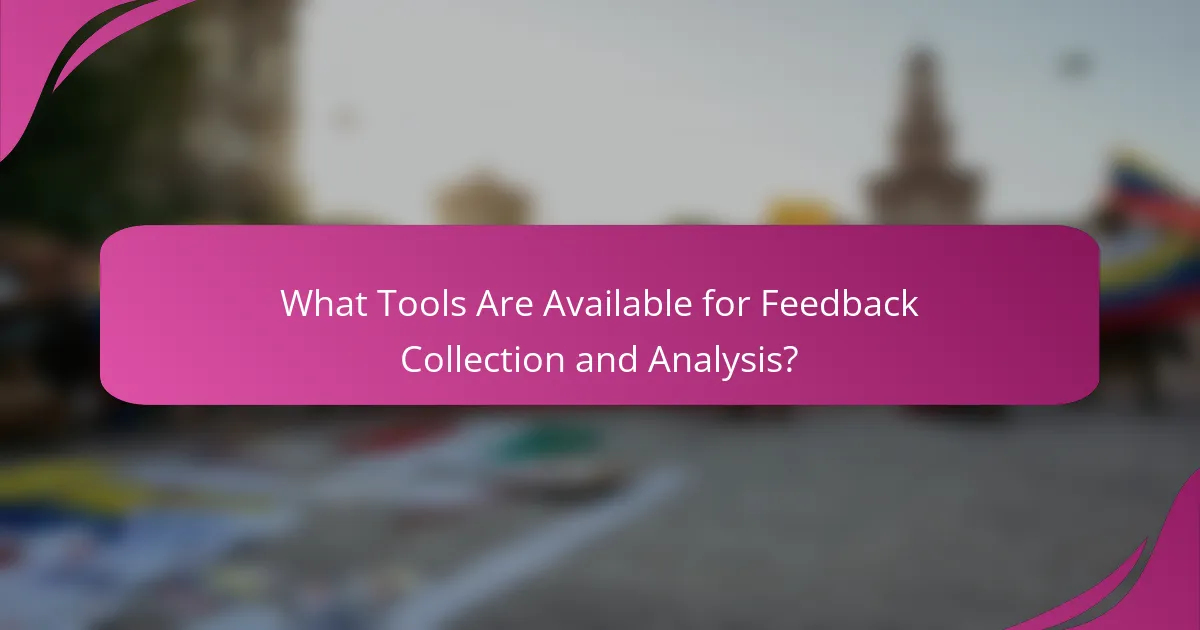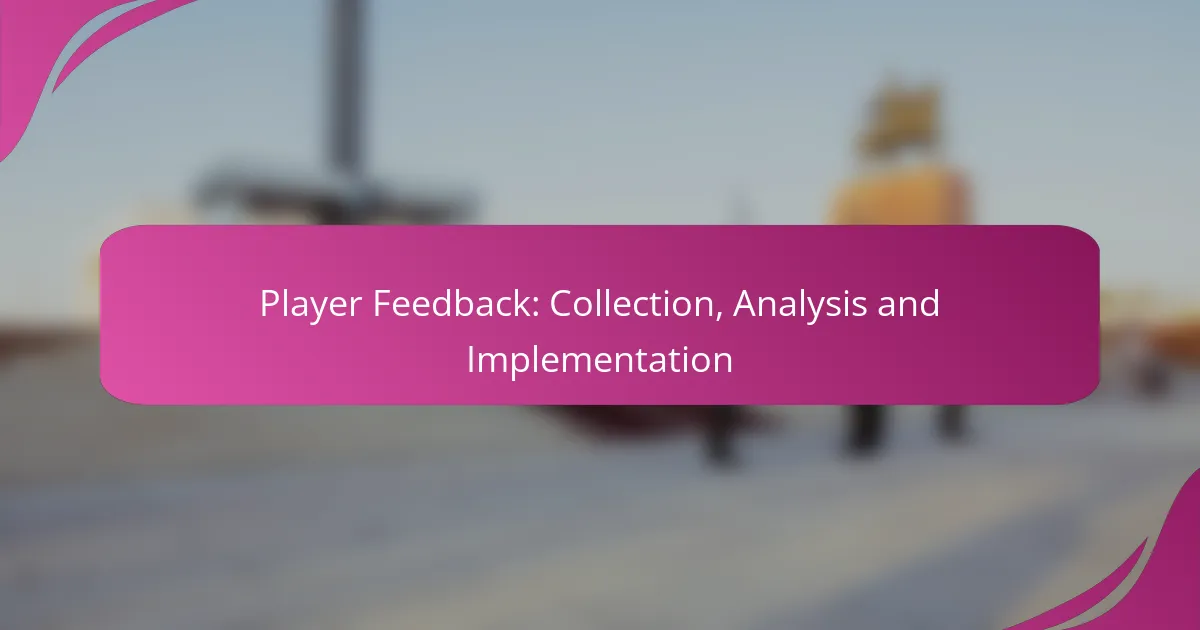Player feedback is crucial for enhancing the gaming experience, and effective collection methods are key to capturing diverse insights. By systematically analyzing this feedback, developers can identify trends and implement meaningful changes that resonate with their player base, ultimately leading to improved gameplay and satisfaction.

How to Collect Player Feedback Effectively?
Collecting player feedback effectively involves using diverse methods to gather insights that can enhance the gaming experience. By employing a mix of tools and strategies, developers can ensure they capture a wide range of opinions and suggestions from their player base.
Surveys and Questionnaires
Surveys and questionnaires are structured tools that allow developers to gather specific feedback from players. They can be distributed via email, in-game prompts, or social media, and should include a mix of multiple-choice and open-ended questions to capture both quantitative and qualitative data.
To maximize response rates, keep surveys concise, ideally taking no more than 5-10 minutes to complete. Offering incentives, such as in-game rewards or entry into a prize draw, can also encourage participation.
In-Game Feedback Tools
In-game feedback tools allow players to provide real-time feedback while they are engaged in gameplay. This can include options like rating systems, bug report buttons, or feedback forms integrated into the game interface.
These tools should be easily accessible and not disrupt the gaming experience. Consider implementing a simple thumbs-up or thumbs-down system for quick responses, along with an option for players to elaborate on their ratings.
Social Media Monitoring
Monitoring social media platforms is crucial for understanding player sentiment and trends. Players often share their experiences and opinions on platforms like Twitter, Facebook, and Reddit, which can provide valuable insights into their preferences and concerns.
Utilize social listening tools to track mentions of your game and analyze the sentiment behind the comments. Engaging with players directly on these platforms can also foster community and encourage further feedback.
Focus Groups
Focus groups involve gathering a small group of players to discuss their experiences and opinions about a game. This qualitative method allows for in-depth discussions and can uncover insights that surveys might miss.
When organizing focus groups, aim for diversity in player demographics and gaming styles. Prepare open-ended questions to guide the discussion, and consider recording sessions for later analysis.
Player Forums
Player forums are online communities where players can discuss their experiences, share feedback, and suggest improvements. These forums can be official or third-party, and they provide a space for ongoing dialogue between players and developers.
Encouraging active participation in forums can lead to valuable insights. Regularly monitor discussions and engage with players to show that their feedback is valued and considered in development decisions.

What Are the Best Practices for Analyzing Player Feedback?
Best practices for analyzing player feedback include using systematic approaches to gather insights, employing various analytical tools, and implementing findings effectively. This ensures that player experiences are understood and improved upon, leading to enhanced gameplay and satisfaction.
Sentiment Analysis Tools
Sentiment analysis tools help quantify player emotions expressed in feedback, allowing developers to gauge overall satisfaction. Tools like Natural Language Processing (NLP) algorithms can categorize comments as positive, negative, or neutral, providing a clear picture of player sentiment.
Popular tools include MonkeyLearn and Lexalytics, which can analyze text from forums, reviews, and social media. When using these tools, ensure data is cleaned and relevant to avoid skewed results.
Data Visualization Techniques
Data visualization techniques transform complex feedback data into easily interpretable formats. Charts, graphs, and heat maps can highlight trends and patterns, making it simpler for teams to identify key issues and successes.
Consider using tools like Tableau or Google Data Studio to create visual representations of feedback data. Effective visualizations should focus on clarity and relevance, avoiding clutter that can confuse stakeholders.
Player Segmentation
Player segmentation involves categorizing players based on their behaviors, preferences, or demographics to tailor feedback analysis. This approach allows developers to understand specific needs and issues faced by different player groups.
Common segments include casual vs. hardcore players or new vs. veteran users. By analyzing feedback within these segments, teams can prioritize improvements that resonate with each group, enhancing overall player satisfaction.
Trend Identification
Identifying trends in player feedback is crucial for understanding evolving player needs and preferences. Regularly reviewing feedback over time can reveal patterns that inform game updates and feature development.
To effectively identify trends, establish a routine for analyzing feedback, such as monthly reviews. Look for recurring themes or issues, and prioritize addressing those that affect the largest segments of your player base.

How to Implement Changes Based on Player Feedback?
To implement changes based on player feedback, it’s essential to systematically collect, analyze, and act on the insights gathered. This process involves using structured methodologies to ensure that player input translates into meaningful updates in the game.
Agile Development Methodologies
Agile development methodologies emphasize iterative progress and flexibility, making them ideal for incorporating player feedback. Teams can work in short cycles, often referred to as sprints, allowing for rapid adjustments based on player insights.
For example, a game development team might release a new feature, gather player feedback within a week, and then refine that feature in the next sprint. This approach ensures that changes are continuously aligned with player expectations.
Prioritization Frameworks
Prioritization frameworks help teams decide which feedback to act on first, balancing player needs with development resources. Techniques such as the MoSCoW method (Must have, Should have, Could have, Won’t have) can clarify which changes will deliver the most value to players.
For instance, if players consistently request a specific feature, categorizing this feedback can help teams focus on implementing it before less critical updates. This structured approach ensures that the most impactful changes are prioritized effectively.
Feedback Loop Creation
Creating a feedback loop involves establishing a continuous cycle of collecting player input, implementing changes, and then gathering further feedback. This process not only enhances player satisfaction but also fosters a sense of community and engagement.
To create an effective feedback loop, consider using surveys, in-game polls, or community forums to gather insights. Regularly updating players on how their feedback has influenced game changes can strengthen their connection to the game and encourage ongoing participation.

What Tools Are Available for Feedback Collection and Analysis?
Several tools are available for collecting and analyzing player feedback, each offering unique features and capabilities. Choosing the right tool depends on your specific needs, such as the type of data you want to gather and how you plan to analyze it.
SurveyMonkey
SurveyMonkey is a popular online survey tool that allows users to create custom surveys easily. It offers a variety of question types, including multiple-choice, rating scales, and open-ended questions, making it versatile for gathering player feedback.
When using SurveyMonkey, consider its templates and analytics features that help streamline the feedback process. You can analyze results in real-time and export data to various formats, which is useful for reporting and further analysis.
Qualtrics
Qualtrics is a more advanced feedback collection platform, ideal for organizations seeking in-depth insights. It provides robust survey capabilities along with powerful analytics tools that can help identify trends and patterns in player feedback.
This tool is particularly beneficial for larger teams or projects, as it supports complex survey logic and integrates with other data systems. However, its pricing may be higher compared to simpler tools, so assess your budget and needs carefully.
Tableau
Tableau is primarily a data visualization tool that can be used to analyze and present player feedback data effectively. While it does not collect feedback directly, it excels at transforming raw data into interactive dashboards and visual reports.
Using Tableau, you can connect to various data sources, including survey results from tools like SurveyMonkey or Qualtrics. This allows you to visualize trends and insights, making it easier to communicate findings to stakeholders. Keep in mind that a solid understanding of data visualization principles is beneficial for maximizing Tableau’s capabilities.
